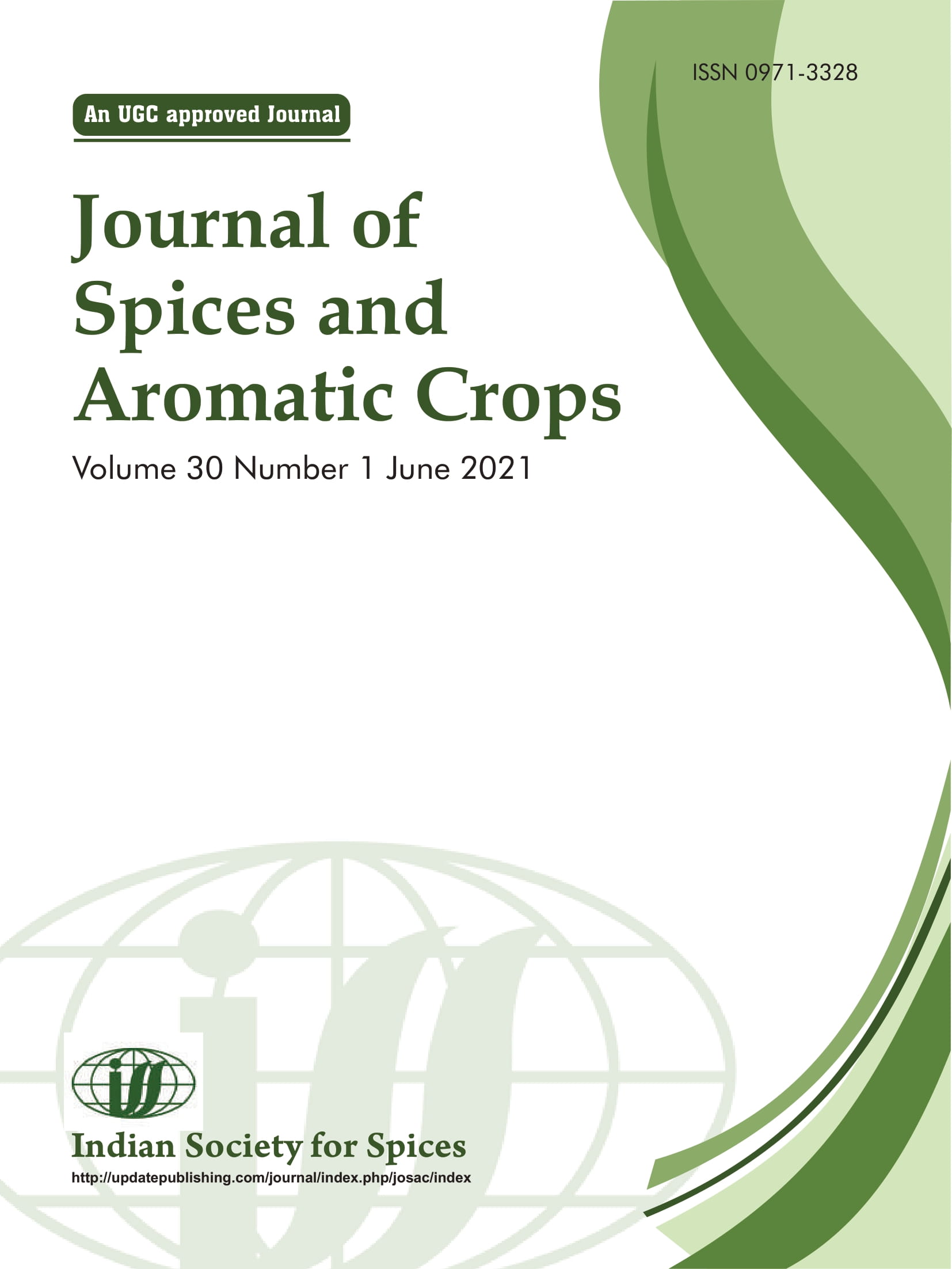Morphological and biochemical properties of garlic (Allium sativum L.) collections
Characterization of garlic collections
DOI:
https://doi.org/10.25081/josac.2021.v30.i1.6571Keywords:
analysis, collections, garlic, microelementsAbstract
Garlic (Allium sativum L.) is an important constituent of many of traditional medicines. The nutrient composition and biochemical ingredients of garlic vary among varieties and locations. The current experiment was conducted with 35 genotypes of garlic to study variation in morphological and biochemical properties among these genotypes. The weight of bulbs ranged from 6.9 g to 22.6 g. Highest number of clove bulb-1 was recorded in collection -286 (44.6) followed by GG-2 (40.6). Clove weight was higher in collection - 316 (1.41 g). The dry weight ranged from 28.6 per cent to 38.65 per cent. Highest total soluble solids were found in collection -79 (35.1°Brix). Potassium, iron and zinc content were higher in GG-2 (1.70%, 47 ppm and 19.2 ppm, respectively). Sulphur and copper content were higher in G-41. Manganese content ranged from 6.90 to 23.1 ppm. Highest anthocyanin pigment was found in the peel of cv. Godavari (5.35 mg). There was not much difference in anthocyanin content in pulp of purple and white colour varieties. Pyruvic acid content ranged from 20.9 µ mol ml-1 to 24.9 µ mol ml-1. Over all cvs. G-50, G-41, collection -316 were found superior over others.
Downloads
References
Anna B, Giulia C, Corrado L, Pasqua L, Giuseppe, Ambacorta & Antonio E 2020 Evaluation of Garlic Landraces from Foggia Province (Puglia Region; Italy). Foods 9: 850.
Anonymous 2018 Horticultural Statistics at A Glance, Horticulture Division, Ministry of Agriculture & Farmers' welfare, Government of India, 458p.
Bhattacharjee S 2013 Analysis of the proximate composition and energy values of two varieties of onion (Allium cepa L.) bulbs of different origin: A Comparative Study. Int. J. Nutr. Food Sci. 2: 246.
Danna D, Lapichino F G & Miceli A 2000 Effect of clove weight on yield and bulb quality of garlic grown for storage. Acta Hortic. 533: 589–592.
Gebreyohannes G & Gebreyohannes M 2013 Medicinal values of garlic: A review. Int. J. Agric. 5: 401–408.
Giusti M M & Wrolstad R E 2001 Characterization and measurement of anthocyanins by UV-Visible spectroscopy. Cur. Protocols in Food Anal. Chem. F1.2.1–F1.2.13.
Gupta R P 2015 A step towards increasing garlic productivity. Cur. Sci. 108: 1414–1419.
Islam D, Lina N N, Roy R K, Chadni L, Zubayed A, Samina A, Liton C M, Evena P L, Mahmuda H & Dipankar C R 2020 Relative proximate composition and mineral analysis of three garlic varieties available in Bangladesh. Europ. J. Med. Plants 31: 1–9.
Panse V G & Sukhatme P V 1995 Statistical methods for agricultural workers. ICAR, New Delhi, 359p.
Piper C S 1966 Soil and plant analysis, Hans Publishers, Bombay, 368p.
Rana S V, Pal R, Vaiphei K, Sharma S K & Ola R P 2011 Garlic in health and disease. Nutr. Res. Rev. 24: 60–71.
Ranganna S 1986 Handbook of analysis and quality control for fruit and vegetable products, Tata McGraw-Hill Publishing Company Lt. New Delhi, 1112p.
Rivlin R S 2001 Historical perspective on the use of garlic. J. Nutr. 131: 951S–954S.
Tattelman E 2005 Health effects of garlic. Am. Fam. Physician. 72: 103–106.
Tripathi P C, Sankar V & Lawande K E 2013 Medicinal and theuraptic value of garlic. Spice India Dec. 14–16.
Woodward P W 1996 Garlic and friends: the history, growth and use of edible Alliums. Hyland House, Melbourne.
Yebirzaf Y, Belete N, Tegibew W, Yohaness G, Abayneh M & Kassahun Y 2018 Collection and characterization of garlic (Allium sativm L.) germplasm for growth and bulb yield at Debre Markos, Ethiopia. J. Hort. For. 10: 17–26.
Yoo K, Sun P, Leonard M & Hamilton B K 1995 Astuplitied pyruvic acid analysis suitable for onion breeding programs. Hort. Sci. 30: 1306.
Published
How to Cite
Issue
Section
Copyright (c) 2021 P C Tripathi, H M Jadhav, A A Qureshi, V Sankar, V Mahajan, K E Lawande

This work is licensed under a Creative Commons Attribution-NonCommercial-NoDerivatives 4.0 International License.






 .
.